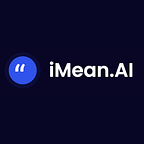The future of AI is Agent? (3/3)
The discourse on the future of work is inescapable. At iMean AI, we’re convinced that the forthcoming professional landscape will be incomplete without the integration of AI assistants or, as they’re increasingly termed, AI agents. In this concluding piece of our AI agent series, we spotlight AutoGPT — arguably the most notable AI agent, and delve into diverse applications of AI agents across sectors.
What is AutoGPT
AutoGPT is like a smart assistant that can handle tasks on its own. It uses the power of GPT-4 and GPT-3.5, the LLMs from Open AI. Unlike other models, it doesn’t just react to user prompts; it creates its own, often extending its search beyond its internal database to fetch authentic information from the web.
How AutoGPT Function?
Because AutoGPT is a recursive AI model, it overcomes traditional AI limitations by using its own results to tackle complex tasks. Here is how the model processes input and delivers relevant output:
- Initialization: Assign a name and role to AutoGPT. This aids in tailoring its responses.
- Data Assimilation: The model learns from the provided dataset, understanding its nuances, patterns and details.
- Prompt Creation: With its knowledge base in place, AutoGPT develops its own prompts based on what it needs to achieve. These prompts serve as the basis for its decision-making, guiding it through the tasks.
- Data Acquisition: Beyond its initial dataset, AutoGPT actively sources additional relevant information from the web.
- Data Verification: All externally sourced data undergoes rigorous checks for authenticity and quality. It removes any incorrect or low-quality information, making sure its knowledge base is reliable.
- Adaptive Learning: Feedback-driven, AutoGPT learns from the results it generates and uses feedback to adapt and enhance its future responses. This ongoing process helps the system refine its strategies and improve over time.
- Response Generation: Based on its cumulative learning and the context, AutoGPT crafts appropriate responses.
AutoGPT unveils itself as an independent problem-solver with impressive decision-making skills. It showcases the sheer power of AI, providing a glimpse into the potential of intelligent systems that effortlessly handle complex tasks with minimal human input. Arguably, AutoGPT paves the way for a future where machines become trusted partners in navigating our intricate world.
What are the applications of AI agents?
Autonomous AI agents have numerous applications in various industries, including:
- Healthcare: AI agents can assist in diagnosing, treating, and monitoring patients. For example, IBM Watson Health is an AI agent that can analyze medical data to identify potential health issues and recommend treatment options.
- Finance: They can analyze financial data, detect fraud, and make investment recommendations. Charles Schwab uses an AI agent called Intelligent Portfolio to create and manage portfolios based on customers’ investment goals.
- Retail: Agents can provide personalized recommendations, improve supply chain management, and enhance customer experience. Amazon’s Alexa is an AI agent that can recommend products, place orders, and track shipments.
- Manufacturing: Intelligent agents can optimize production processes, predict maintenance needs, and improve product quality. General Electric uses an AI agent called Predix to monitor machines in real-time to predict and prevent equipment failures.
- Transportation: Autonomous AI agents can assist in route planning, traffic management, and vehicle safety. Tesla’s Autopilot helps drive a vehicle autonomously and helps the driver park, lane change, and safe driving.
- Education: They can provide personalized learning experiences, automate administrative tasks, and analyze student performance. Pearson’s AI agent, Aida, can provide feedback to students and suggest personalized learning paths.
- Agriculture: AI agents can optimize crop production, monitor soil quality, and predict weather patterns. John Deere uses an AI agent called See & Spray to detect and target weeds without affecting crops.
As we conclude our series, we remain optimistic and curious about the myriad ways these agents will redefine professions, enhance productivity, and foster collaborations. The future isn’t just about coexisting with machines; it’s about thriving alongside them. Join iMean AI in embracing this exciting epoch of innovation and discovery.
Try iMean AI FOR FREE now: https://chrome.google.com/webstore/detail/imean-generative-ai-meets/kjbmffebjpefbpfokhammhcnknnebhab?hl=en-GB&authuser=0
